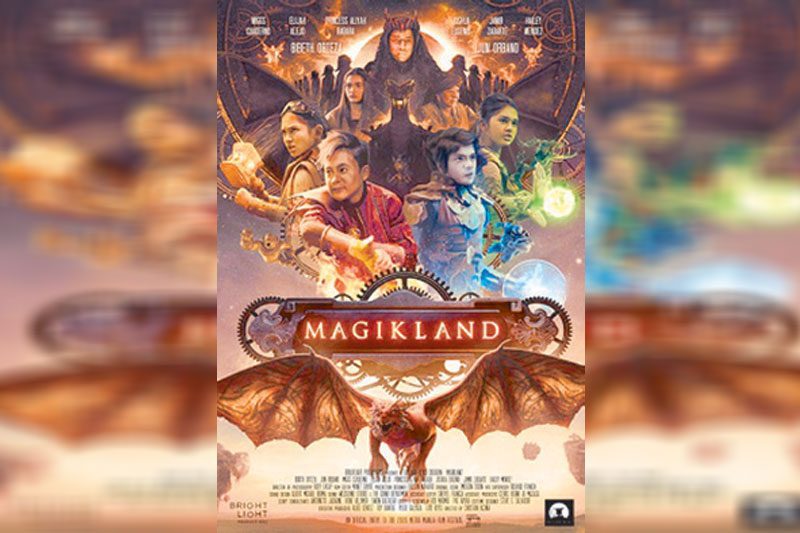A film for Filipino children
The Visayan Daily Star
Published on: 12/29/2020 | Section: Starlife
By Vicente Garcia Groyon
Published on: 12/29/2020 | Section: Starlife
By Vicente Garcia Groyon


Premiering in this year’s Metro Manila Film Festival is a fantasy film with Negrosanon roots – Magikland – the directorial debut of Christian Acuña, and produced by Brightlight Productions.
Conceived as a companion to the Magikland theme park in Silay City, the film establishes and introduces the mythos underlying the park’s attractions. While the park’s grand opening remains postponed due to the pandemic, the film can now be enjoyed worldwide during the online festival, and will be available to stream on demand soon after that.
The project was helmed by the creative team of Peque Gallaga and Lore Reyes, who opted to serve as executive producers and creative consultants, and selected Acuña to direct. Acuña, who already has numerous advertising credits and short films under his belt, brings a youthful perspective and technological savvy to the film, that revolves around an online game with magical properties.
The game’s four top-scoring players are sucked into the world of the game, and they must play as themselves to save Magikland from the clutches of an evil villain. Structured as a quest narrative, the film moves according to the pace and logic of a video game, leaping through space and time as the heroes complete game levels and approach their goal which is, appropriately, a final “boss battle”.
The fictional online game of the film seems to be a heightened version of Pokemon Go. In the Magikland game, the augmented reality feature is used by gamers to seek out rewards, solve puzzles, and accomplish tasks while moving through the real world. Players can meet up with other players and join forces to accomplish cooperative goals.
The film features four charming young actors in the lead roles—Miggs Cuaderna, Princess Rabara, Elijah Alejo, and Joshua Eugenio— although Eugenio steals the show with a playful guilelessness rare in child actors. The leads are supported by a dizzying succession of cameo appearances from some of the best actors in the business, many of them virtually unrecognizable under elaborate costumes and make-up.
Magikland hews close to the Gallaga-Reyes brand of children’s fantasy films exemplified by Batang X (1995), Magic Temple (1996), and Magic Kingdom: Alamat ng Damortis (1997), in which sci-fi and fantasy conventions are grounded in a contemporary Philippine idiom while building worlds and mythologies rooted in Pinoy history and culture.
Magikland also draws imagery and tone from Gallaga’s Once Upon a Time (1986), in which fantastical elements invade and interact with real, recognizable Metro Manila settings.
What sets apart the Gallaga-Reyes children’s films is their emphasis on depicting children as autonomous, recognizably Pinoy heroes who learn how to make decisions and take actions that have an impact on the world around them. Whereas in other films children are treated as secondary, passive, or controlled by adults, the four pubescent protagonists of Magikland fend for themselves and discover their inner strengths and wisdom to attain good ends. Even the film’s villain, played by Jamir Zabarte, is only slightly older than the heroes, reminding us that these children could easily end up like him if they make the wrong decisions.
While a good portion of the film was shot on location in Metro Manila, with other provinces like Rizal, Laguna, Nueva Ecija, and Ilocos Norte doubling for Magikland locales, a substantial number of the images were created on a sound stage and in a computer. About half of the film’s 170-million-peso budget went into digitally constructing the world of the film, and the final cut contains more computer graphic imagery (that took 26 months to produce) than any Filipino film produced, so far.
The film’s look and design maintains a video game aesthetic, that helps to excuse certain effects lapses and less-than-convincing rendering, and it works. The film transports viewers right into a video game and our attention is where it should be: on the young heroes’ struggles and moral dilemmas as they try to win the game.
Ultimately, this foregrounding of values formation without coming across as preachy or corny is the ultimate value of Magikland. By providing positive, entertaining, and local models of decent behavior, films like this are a necessary alternative to foreign franchise films and vapid escapist fare. It’s a film you can feel comfortable showing to Filipino children, knowing that they’ll see and recognize their best selves reflected back at them.
Magikland streams online at https://upstream.ph/movies/magikland/ through January 7.